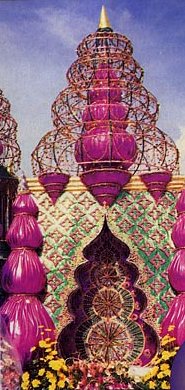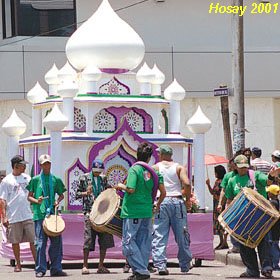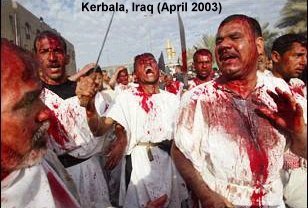
 Every year, Hosay is observed with a parade full of colorful tadjahs (as shown in the pictures) in commemoration of the martyrdom of Hussain (Hussein), the grandson of Muhammad, the Prophet of Islam, in the year 680 AD.
Every year, Hosay is observed with a parade full of colorful tadjahs (as shown in the pictures) in commemoration of the martyrdom of Hussain (Hussein), the grandson of Muhammad, the Prophet of Islam, in the year 680 AD.
 Every year, Hosay is observed with a parade full of colorful tadjahs (as shown in the pictures) in commemoration of the martyrdom of Hussain (Hussein), the grandson of Muhammad, the Prophet of Islam, in the year 680 AD.
Every year, Hosay is observed with a parade full of colorful tadjahs (as shown in the pictures) in commemoration of the martyrdom of Hussain (Hussein), the grandson of Muhammad, the Prophet of Islam, in the year 680 AD.
After the death of the Prophet Muhammad in 632 AD, the selection of his successor (caliph) created a rift within the Muslim community. One faction adhered to the minority belief that succession to the head of Islam must be through the family of the prophet Muhammad; the other faction held the majority viewpoint that succession must be based on selection from the elite families of Mecca, Saudi Arabia, with approval by all Muslims. Between 632 AD and 680 AD, there were seven caliphs, all with some relationship to Muhammad: Abu-Bakr (632 AD), father-in-law; Umar (634 AD), father-in-law; Uthman (644 AD), son-in-law; Ali (656 AD), son-in-law; Hassan (661 AD), grandson (son of Ali); Mu'awiyah (661 AD), brother-in-law; and Yazid (680 AD), son of Mu'awiyah. In 661 AD, Hassan, the grandson of Muhammad, stepped down after six months in favor of Mu'awiyah; he died in 669 AD after being poisoned.
In 680 AD, Hussain, the other grandson of Muhammad, did not agree with Yazid's succession of his father, Mu'awiyah, as caliph. He believed that that revered position should be filled by Muhammad's first cousin and son-in-law, Ali. He then left Medina for Kufah, Iraq, to join his supporters, before heading for Damascus, Syria, to discuss his concerns with Yazid. He was intercepted in Kerbala (Karbala), Iraq, after Yazid issued an order to his forces to capture Hussain and bring him to Damascus if he refused to accept Yazid as the caliph. Hussain's party was attacked by Yazid's forces in Kerbala where they refused to recognize Yazid, evaded capture, and defended themselves for 10 days before all the men in the party were slain along with some children; the women were unharmed.
 Centuries after the battle at Kerbala, Hussain's tragic death became a landmark in the rift between Muslims of the minority opinion (Shiites, Shi'ah), supporters of Ali, and those of the majority opinion (Sunnis). Hussain's martyrdom at Kerbala (Hosay) is observed annually by Shiites during Muharram, the first month of the Islamic lunar calendar. This observance occurs during a different calendar-month every year because the lunar year is about 11 days shorter than the solar (Gregorian) year. Thus, the observance arrives about a month earlier every three years, rotating through the four seasons in 33 years.
Centuries after the battle at Kerbala, Hussain's tragic death became a landmark in the rift between Muslims of the minority opinion (Shiites, Shi'ah), supporters of Ali, and those of the majority opinion (Sunnis). Hussain's martyrdom at Kerbala (Hosay) is observed annually by Shiites during Muharram, the first month of the Islamic lunar calendar. This observance occurs during a different calendar-month every year because the lunar year is about 11 days shorter than the solar (Gregorian) year. Thus, the observance arrives about a month earlier every three years, rotating through the four seasons in 33 years.
Shiites around the world observe Hosay in different ways. In Kerbala, Iraq, mourners shed blood by beating themselves with swords (see picture at right). In Lucknow, India, the centre of Shiite culture in India, it is observed with great passion with tadjahs (taziyas), drums, and mourners who reenact the Battle of Kerbala with chants of "Hussain!" This custom was brought to Trinidad by East Indian Shiites who migrated from India in the 19th century. The first observance of Hosay in Trinidad has been traced back to 1854, eleven years after the first indentured laborers arrived from India. However, maintaining the Hosay tradition was not always an easy task. After a ban on all types of parades was imposed by the British colonialist government in 1884 following riots on sugar estates, approximately 30,000 people defiantly took to the streets for Hosay in Mon Repos, San Fernando, on Thursday, October 30, 1884. After shots were fired by the police to disperse the procession, 22 men were killed and another 120 were wounded. That fateful day is commonly referred to in Trinidad history as the "Hosay Massacre."
 Hosay parades take place in two Shiite communities in Trinidad: St. James, in the western section of Port-of-Spain, and Cedros, in the South. The colorful procession in St. James is the largest (five tadjahs) and draws thousands of spectators of all religions every year. The Shiites of St. James spend a considerable amount of time and money in the building of miniature temples (tadjahs, taziyas, hosays, mausoleums) with bamboo, wood, paper, and tinsel to depict the tomb of Hussain. These tadjahs range in height from 10 to 30 feet and are hauled through the streets on parade days accompanied by the beating of drums (tassas) and two standards in the shape of half-moons, each carried separately on the shoulder of one man at a time. The half-moons (one red and one green) symbolize the deaths of both Hussain and his brother Hassan; red for the blood of Hussain that was shed at Karbala and green for the poisoning of Hassan, 11 years earlier. The drums and flags are symbolic of those used in wars in the 7th century. Hosay parades take place in two Shiite communities in Trinidad: St. James, in the western section of Port-of-Spain, and Cedros, in the South. The colorful procession in St. James is the largest (five tadjahs) and draws thousands of spectators of all religions every year. The Shiites of St. James spend a considerable amount of time and money in the building of miniature temples (tadjahs, taziyas, hosays, mausoleums) with bamboo, wood, paper, and tinsel to depict the tomb of Hussain. These tadjahs range in height from 10 to 30 feet and are hauled through the streets on parade days accompanied by the beating of drums (tassas) and two standards in the shape of half-moons, each carried separately on the shoulder of one man at a time. The half-moons (one red and one green) symbolize the deaths of both Hussain and his brother Hassan; red for the blood of Hussain that was shed at Karbala and green for the poisoning of Hassan, 11 years earlier. The drums and flags are symbolic of those used in wars in the 7th century.
|
 In St. James, the main parade of tadjahs takes place along the Western Main Road on the 10th day of Muharram; this day is called Aashura. Aashura is the "Day of Atonement" for all Muslims and was observed long before the martyrdom of Hussain which, coincidentally, occurred on the same day. The three days preceding Aashura are also filled with parades, as laid out in the Table (Hosay Events) below.
In St. James, the main parade of tadjahs takes place along the Western Main Road on the 10th day of Muharram; this day is called Aashura. Aashura is the "Day of Atonement" for all Muslims and was observed long before the martyrdom of Hussain which, coincidentally, occurred on the same day. The three days preceding Aashura are also filled with parades, as laid out in the Table (Hosay Events) below.
Prior to 1996, there were only four Hosays before the Emamali and Bisnath families decided to build separate tadjahs. The order of the tadjahs in the parades is inviolable and is based on longevity as follows: (1) Panchayatee (Bay Road) Hosay - belonging to the entire Shiite community and located on Mathura Street (previously on Bay Road); (2) Ghulam Hussein Hosay - named after one of the local icons of Hosay and located on Western Main Road; (3) Cocorite Hosay - belonging to the community of Cocorite at the western end of St. James; (4) Balma Hosay - belonging to the Emamali family and located on Clarence Street; and (5) Bisnath Hosay - belonging to the Bisnath family and located on Bournes Road.
 Every year, the procession follows a set route that is believed to retrace the path that was used for the event when St. James was a plantation during the middle of the 19th century: east on Western Main Road to Serpentine Road, Hayes Street, and Queen's Royal College (QRC), before returning to St. James along the same route. The procession starts from St. James early enough to reach the campus of QRC by 3:30 p.m., the time that Hussain was martyred in Karbala. At QRC, the only publicly visible religious aspect of Hosay is displayed with the reading of the funeral (genesa) prayer. (See picture at left.) On the 13th day of Muharram (Teejah Day), the Hosays are hauled to the seaside in Cocorite and broken up. Click Here to view a video of the November 2012 Hosay parade in St. James, Trinidad.
Every year, the procession follows a set route that is believed to retrace the path that was used for the event when St. James was a plantation during the middle of the 19th century: east on Western Main Road to Serpentine Road, Hayes Street, and Queen's Royal College (QRC), before returning to St. James along the same route. The procession starts from St. James early enough to reach the campus of QRC by 3:30 p.m., the time that Hussain was martyred in Karbala. At QRC, the only publicly visible religious aspect of Hosay is displayed with the reading of the funeral (genesa) prayer. (See picture at left.) On the 13th day of Muharram (Teejah Day), the Hosays are hauled to the seaside in Cocorite and broken up. Click Here to view a video of the November 2012 Hosay parade in St. James, Trinidad.
| HOSAY EVENTS | ||
|---|---|---|
| DAY | EVENT | DESCRIPTION |
| 1st Day of Muharram | Prayers | As the construction of the tadjahs continues, prayer meetings are held at each Hosay site (yard). |
| 7th Day of Muharram | Flag Night | This is the first night of processions on the streets and representatives from each Hosay yard parade with flags and drums. |
| 8th Day of Muharram | Little Hosay Night | This is the second night of processions when small replicas of the two tombs (hosays) of Hussain and Hassan are paraded on the streets with the beating of drums. |
| 9th Day of Muharram | Big Hosay Night | The tadjahs are brought into public view for the first time, together with standards in the shape of half-moons, and are paraded on the streets with the beating of drums. |
| 10th Day of Muharram (Aashura) | Kerbala Day | This is the final parade day. |
| 13th Day of Muharram | Teejah Day | The tadjahs are taken to the sea in Cocorite and broken up. |
Copyright © 2000-2014 All rights reserved.